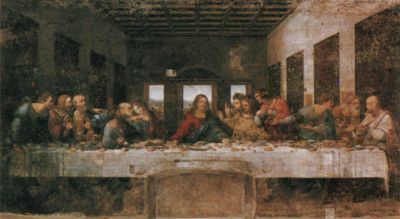Last Supper

The Last Supper was Jesus' final meal with his Apostles before the Passion of Christ. This event, which was held in an upper room in or around Jerusalem, is described in detail in all four Gospels. Today the room is thought to have been the Cenacle, located on the second floor of a building that is claimed by all three major religions: Judaism (for housing King David's tomb), Christianity, and Islam.[1]
The room is unknown but probably belonged to a follower of Jesus, as the Apostles continued to meet there after the Resurrection. Subsequently, it became the first church in Jerusalem, known as the Church of the Apostles or the Church of Sion.[2]
There were many defining moments of the Christian faith at the Last Supper:
- Jesus' washing of the feet of the Apostles, despite their objection.
- Jesus' breaking of the bread now repeated in the Eucharist by Christians worldwide.
- Jesus' final instructions to the Apostles.
- Jesus' identification of the one (Judas Iscariot) who was to betray Him.
- Peter's promise, later broken under the stress of the Passion of Christ, not to deny Jesus.[3]
Leonardo da Vinci drew Jesus's Last Supper on a wall in 1498, and it was immediately recognized as a masterpiece. This artwork depicts the institution of the Eucharist, an essential aspect of Christianity. Each Apostle, and Jesus Himself, is shown in very human and expressive terms. There are no halos or signs of saintliness in this painting. Instead, everyone's human side is displayed with emotion and feeling.
Unfortunately the painting has deteriorated along with the wall on which it rests. It has been repainted several times in efforts to restore it.
See also
External links
- The Days of Holy Week
- Holy Week Catholic Encyclopedia.
References
- ↑ https://www.npr.org/2012/04/05/150016572/vatican-israel-spar-over-disputed-last-supper-site
- ↑ Destroyed and rebuilt in the second millennium, this room was under the authority of the Franciscans until 1561. Now it is a Moslem mosque.
- ↑ Peter later wept bitterly when he realized that he had denied Jesus.